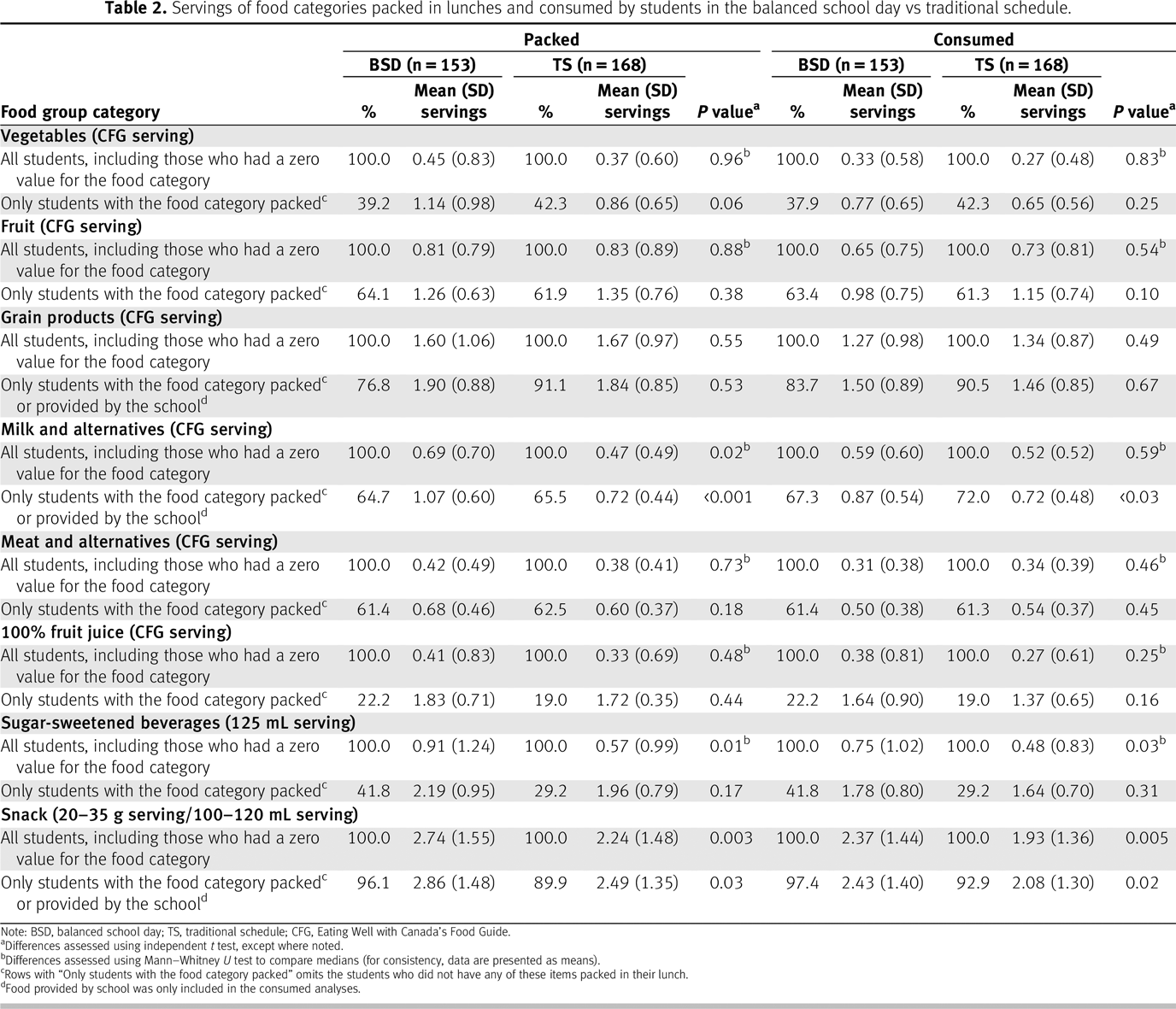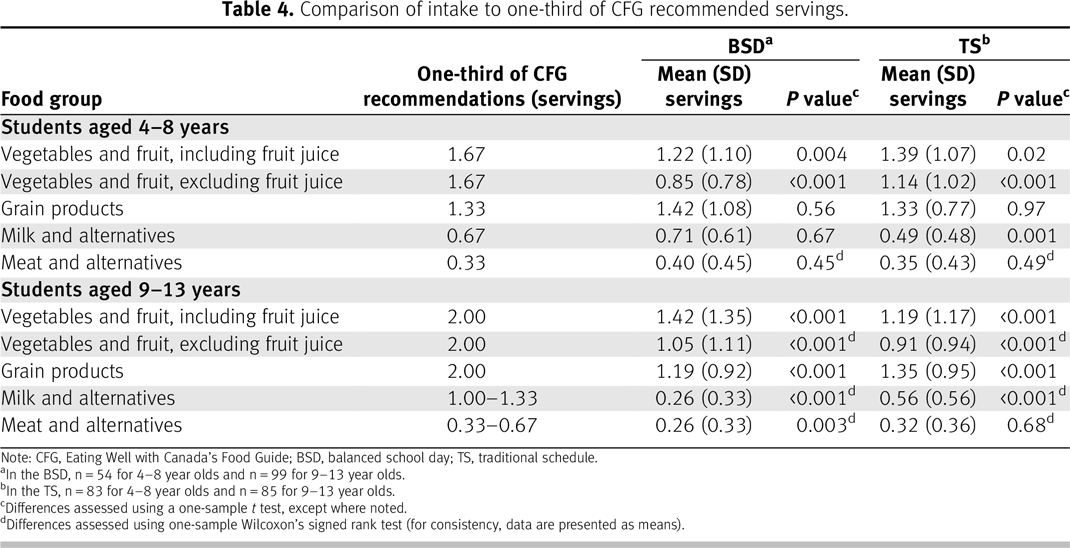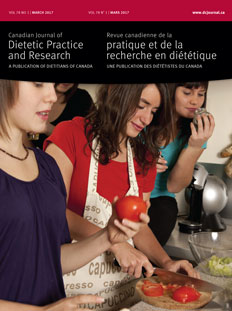INTRODUCTION
In Canada, most foods consumed in elementary schools are brought from home, as school meal programs are not publically funded [
1]. Some foods are available for purchase at school; however, purchases are generally from external food caterers or franchisees and the frequency of availability varies by school. Unfortunately, home-packed lunches in the United Kingdom and United States are of lower nutritional quality than school meals, providing more savoury and confectionery snacks and fewer fruit and vegetables [
2–
4]. Few studies have examined the quality or type of foods packed at home and consumed by Canadian school children. One study, however, found the nutritional quality of both home-packed and school-purchased lunches was lacking when compared with one-third of the Dietary Reference Intakes for magnesium, potassium, zinc, folate, fibre, and vitamins A, D, C, and B6 [
5]. In this study, foods purchased from school were provided by external sources, including fast-food outlets.
In addition to concerns about home-packed lunches, there have also been changes to the elementary-school schedule in some provinces in Canada that may impact children’s consumption of foods at school [
6]. The balanced school day (BSD) provides an alternative schedule for school-day breaks, compared with the well-established traditional schedule (TS) [
6]. This alternative schedule was a staff-driven timetable change that addressed the specific needs of an Ontario school in 2000–2001, and it has since been implemented in many other individual schools and/or school boards [
6,
7]. The BSD has two 45-minute breaks, each with 20 minutes for eating and 25 minutes for recess [
6]. In comparison, the TS provides 20 minutes for eating at lunch together with 40 minutes for recess, plus two 15-minute recesses for snacks and/or activities [
6,
8]. According to school board websites, widespread implementation of the BSD has occurred in Ontario, but the extent is difficult to quantify as it is neither government mandated nor monitored [
9–
11]. Limited evaluation of the potential health impacts (e.g., children’s food intake) has taken place. One study, comparing nutrient compositions of packed lunches consumed by students attending 1 BSD to 1 TS school, found significantly more beverages were provided in BSD home-packed lunches (1.42 vs 1.18 beverages per day,
P = 0.04), but the volume and calories from beverages were not significantly different, nor were the intakes of macronutrients and micronutrients [
12]. More data using a larger number of schools and students is required; however, because it is possible that with 2, instead of 1, 20-minute eating breaks, parents may pack more food and beverages in their child’s lunch. The purpose of the present study was to compare the type, quantity, and adequacy of foods children are bringing and consuming at schools implementing the BSD compared with those at TS schools, using a valid and reliable direct observation method [
13].
RESULTS
Of the 25 schools invited to participate, 10 TS and 9 BSD (71.4% and 81.8% response rate, respectively) schools agreed. Third- and fourth-grade children from 19 elementary schools (10 TS, n = 168; 9 BSD, n = 153) in Southwestern Ontario participated. Of the 731 children invited, 339 (46%) provided consent; however, the final response rate was reduced to 321 (44%), because 18 children were not available on observation days.
Characteristics of students are shown in
Table 1. There were no significant differences between school schedules for sex, grade, or school location (urban vs rural). Students in the BSD were 3 months older than those in the TS (
P < 0.001). Milk was available for students to purchase through school milk programs in 67% of BSD and 100% of TS schools.
A higher proportion of children in the BSD had SSBs and snacks packed in their lunch than TS children (41.8% vs 29.2% and 96.1% vs 89.9%, respectively,
P < 0.05 for both;
Table 2). There were no differences in other packed-food categories (
Supplementary Figure 11). With respect to each BNS snack classification there were no significant differences by school schedule in the proportion of students with the items packed (data not displayed). The most prevalent BNS classification was baked goods with 71.9% of BSD and 63.7% of TS packed lunches containing these items (not significant; data not displayed).
BSD students had more Milk/Alt, SSB, and snack servings packed than TS students (
Table 2). Servings of snack and Milk/Alt items packed in lunches remained significantly higher in BSD lunches when students, who did not have the food category packed, were excluded. Although more BSD students than TS students had a SSB in their lunch (41.8% vs 29.2%,
P < 0.05), the portion size of SSBs was similar between schedules when the analysis was confined to children who had a SSB packed in their lunch.
When comparing servings of food categories consumed (
Table 2), SSBs and snacks were higher in the BSD versus TS schools. Students in the BSD schools also consumed more servings of Milk/Alts and snacks when the analysis included only those who had the category available to them (i.e., packed in their lunch, purchased from school, or provided through a snack program). Correlations between parental SES variables and Milk/Alt, SSB, and snacks (both packed and eaten) revealed that the only significant associations (
P < 0.05) were with parental education and snacks (packed and eaten); however, the level of association was very low (r = −0.14 and −0.13, respectively), signifying little to no relationship. This suggests that parental SES is not responsible for the observed differences.
Table 3 shows the proportion of children achieving one-third of CFG recommendations for both packed and eaten food groups. More BSD packed lunches than TS provided enough Milk/Alts to meet one-third of daily recommendations; however, in both schedules less than half of children had adequate intakes of Milk/Alts.
Stratified by CFG age-specific recommendations for children aged <9 years in both schedules, vegetable and fruit intake was significantly below one-third CFG recommendations (
Table 4), and it was even lower with fruit juice excluded. TS students consumed < one-third of CFG recommendations for Milk/Alts; however, consumption of Milk/Alts by BSD students met recommendations.
In both schedules, the mean intake of students aged ≥9 years failed to meet one-third of CFG recommendations for grain products, Milk/Alts, and vegetables and fruit. BSD students aged ≥9 years consumed less meat and alternatives servings than recommended, whereas intake by TS students did not differ from recommendations (
Table 4).
Regardless of school schedule, only 40.8% of students had vegetables and 62.9% had fruit (
Supplementary Figure 11 displays data by school schedule), with 80.1% having vegetables and/or fruit. The proportions of children whose consumption met one-third of CFG recommendations for vegetables and fruit was also poor (27.5% BSD and 31.0% TS, not significant), and were further reduced when fruit juice was excluded from the analysis (16.3% BSD and 23.8% TS, not significant) (
Table 3). For all students, the proportion of vegetables left uneaten was higher in both schedules (30% BSD and 20% TS), compared with <15% of snacks and SSBs left uneaten in both the BSD and TS (
Supplementary Table 11).
DISCUSSION
This study is one of the first to investigate differences in packed-lunch contents and consumption of children in the BSD versus TS. A greater proportion of BSD students had snacks packed in their lunches, and the number of servings of snacks packed was also greater in the BSD. More BSD students had a SSB packed in their lunch; however, those who had a SSB packed had the same serving size on average, regardless of schedule. The results of Dorman et al. [
12] also showed that children on the BSD had more beverages per day, although not confined to SSBs, yet there was no difference between schedules for total volume consumed [
12]. Parents of children in the BSD may be providing a SSB, in addition to the beverage they would typically pack (e.g., water, milk, or 100% fruit juice), to ensure their child has something to drink during each 20-minute eating period.
The percentage of students with Milk/Alts in their lunch was similar between schedules, but the number of servings packed was significantly greater in BSD lunches. This is likely related to more TS schools offering a milk program to students, prompting TS parents to pack fewer Milk/Alts. This is also a probable explanation for fewer TS packed lunches meeting one-third of CFG recommendations; however, the proportion of children in the TS who consumed adequate Milk/Alts increased (compared with the proportion with Milk/Alts packed) due to consumption from milk purchased at school. Even after accounting for those who purchased milk from school, the average serving of Milk/Alts consumed was greater for BSD than for TS students. It is important to note, however, that less than 50% of students adequately met one-third of CFG recommendations for Milk/Alts, and the mean number of servings of Milk/Alts consumed by older students in both schedules was well below recommendations and also lower than that reported by another Canadian study of milk consumption during school lunches [
26]. Similarly, fewer home-packed lunches in the United Kingdom and the United States provided a dairy item when compared with school-provided meals [
4,
27]. In the American GREEN (Growing Right: Eating Eco-Friendly & Nutritious) Project Lunch Box Study, only 31% of home-packed lunches and 12% of home-packed snacks contained a portion of milk, yogurt, or cheese, and very few lunches (15%) and snacks (1%) met the federal school nutrition standard for milk (1 cup) [
19]. Thus, promotion of Milk/Alts in home-packed lunches in both schedules appears necessary; however, further investigation of the possible reasons for this may be warranted. It is not known if parents have concerns about refrigeration, price, waste, or child preference. Certainly, low-fat milk would be a beneficial alternative to SSBs, as it provides less energy from sugar and is nutrient dense.
Compared with TS students, more BSD students received a snack in their home-packed lunch, and a greater number of snack servings were both packed and consumed in the BSD. Baked goods (e.g., cookies, granola bars) were the most common snacks packed in both school schedules. Snacks are also common in elementary school home-packed lunches in the United States, United Kingdom, and New Zealand [
2,
17,
18]. In the United Kingdom, Evans et al. [
2] reported that 60% of home-packed lunches contained savoury, 63% confectionery, and 40% both savory and confectionery snacks, none of which aligned with school-meal standards. Similarly, chips, cookies, and other snack foods were found in 28%–40% of American home-packed lunches [
18] and 45%–57% of New Zealand home-packed lunches [
17]. In another study, U.K. students with home-packed lunches consumed more non-permitted snacks, according to school-meal standards, than students with school meals, resulting in higher intakes of sugar, sodium, and percent of energy from saturated fat [
3]. In contrast to the previous home-packed lunch literature, more students in our study had a snack item packed (89.9% TS and 96.1% BSD), probably due to the broader snack definition used in the present study. Some snack items may be perceived as healthy because they fit into a CFG category (e.g., individually packaged cheese, yogurt tubes); however, these items are packaged and marketed for consumption as snacks and often have high levels of fat, sugar, or salt. Also, they were not consumed as the main entrée, and as such, they were considered a snack, as per the research definition. Forthcoming nutrient analysis of these specific items will provide further insight on the nutritional quality of snacks being consumed in schools. Nevertheless, given the findings of previous packed-lunch studies, it is likely that greater portions of snacks consumed in the BSD are contributing to additional sugar, sodium, and saturated fat in BSD students’ intake during school.
Vegetables were packed in fewer students’ lunches than were other food categories. The mean serving size of vegetables was also quite small. These findings are consistent with other home-packed lunch studies, where vegetables have been found in only 5% [
18], 11% [
19], 13% [
4], and 18% [
2] of home-packed lunches. In the current study, a greater proportion of students received vegetables in their lunch (42.3% TS and 39.2% BSD), which may be due to the inclusion of all observed vegetables, including those contained within entrees or sandwiches. The average serving of vegetables and fruit consumed by students in both schedules did not meet one-third of CFG recommendations; however, it was comparable with the serving size found in another Canadian lunch study [
28]. Overall, less than 50% of BSD and TS children met CFG recommendations for vegetable and fruit consumption, even when fruit juice was included as a serving. Notably, a greater proportion of observed packed vegetable servings were being left uneaten in both schedules, whereas snacks and SSBs were seldom left unconsumed. This is concerning because high sugar intake, from food items such as snack foods or SSBs, has been associated with decreased vegetable and fruit consumption and weight gain [
29–
31]. If parents pack high-sugar foods and beverages, these items may displace vegetables and fruit, with children becoming satiated after consuming the preferential high-sugar foods and returning their packed vegetables and fruits home.
Multi-stakeholder approaches to increasing children’s vegetable and fruit consumption, while discouraging intake of SSBs and high-fat/high-sugar snacks, are warranted, particularly in the BSD, as consumption behaviours learned in childhood often extend into adulthood [
32]. Multi-component interventions have been effective at increasing vegetable and fruit intake in a school setting [
33,
34]. Education could support families by raising awareness of the importance of healthy eating for children and providing approaches to overcoming barriers to packing a healthy lunch. The American Academy of Pediatrics [
35] recently identified the unregulated nature of home-packed lunches as an opportunity for pediatricians to collaborate with relevant health professionals such as dietitians, students, parents, and school staff to promote nutrient-rich foods in home-packed lunches, while limiting foods and beverages that provide few nutrients. Changes in children’s intake at school will require the concerted efforts of government and school boards, principals and teachers, parents, students, health professionals, and community members to address barriers parents encounter when packing lunches (e.g., financial, time, picky eating, allergy policy, etc.) [
1, unpublished data].
A limitation of the present study relates to the unobtrusive nature of direct observation, whereby observers were only able to record visible food and beverages. Some food items, such as vegetables or fruit, may be underreported as packed items if children did not remove them from their lunch bag. This approach, however, minimizes unintended changes in food intake that could occur with more intrusive assessments. This observation methodology must also be interpreted as a strength, as it did not rely on parental proxy or student recall. Furthermore, our study assessed food intake at school, thus comparisons to one-third of CFG should be interpreted with caution as total daily food-group intake may be adequate once total 24-hour intake is accounted for. This could be especially apparent for food groups where parents have concerns about food safety (e.g., Milk/Alts). Although our school response rate was 76%, the individual participation rate was 44%; however, this is higher than the 32% participant response rate in Hubbard et al. [
19]. Finally, only 1 cross-sectional observation day was collected per child, which represents group-level intake, but cannot be inferred to individual, usual intake [
36].







